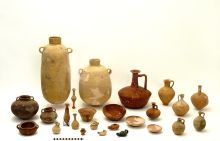This is according to a new study at Bar-Ilan University and the Lawrence Berkeley National Laboratory in California.

Pottery from the Jewish Quarter, in the Old City of Jerusalem, from which and others in their surroundings the samples were taken that proved high concentrations of silver (dated from 30 to 10 AD). Photography: Gabi Larom.
A joint team of researchers from Bar-Ilan University and the Lawrence Berkeley National Laboratory in California found high concentrations of the element silver in ancient pottery in Jerusalem. The vessels, of various types, were discovered in archaeological excavations in Jerusalem in layers from the late Second Temple period (end of the first century BC - 70 AD).
The study, the results of which are published in the latest issue of the Oxford University journal Archaeometry, is the first study in the world to examine silver concentrations in archaeological pottery.
The joint research team was led by Prof. David Aden-Biovitz from the Martin Zoss Department of Land of Israel Studies and Archeology at Bar-Ilan University and a visiting researcher at the Lawrence Berkeley National Laboratory, Dr. Frank Esro and Robert Jayuk, from the Department of Environmental Energy Technologies at Berkeley Lab . The research was funded by the US National Science Foundation and the US-Israel Binational Science Foundation.
The researchers measured the concentrations of silver in 1,200 pottery vessels from 38 archaeological sites from the ancient Roman period in the Land of Israel, meaning the end of the Second Temple period. They did this using a new analytical method they developed, which was found to be more reliable than other methods for measuring silver concentrations in archaeological pottery. "We conducted a series of experiments," explains Prof. Aden-Biovitz, "We tested concentrations of silver in pottery from urban and rural sites, and from various excavation sites from different periods in Jerusalem itself. The tests included vessels from Jerusalem and other sites identical in their period, shape and chemical composition, except for the differences in the concentrations of silver found in them. The results showed that the concentrations of silver in vessels from Jerusalem from the end of the Second Temple period are significantly higher than the samples from all other sites and the concentrations of silver in later vessels from Jerusalem."
Abnormal concentrations of silver were also discovered in several pottery vessels from other cities (Beit Shan, Dor and Tzipori). However, the concentrations of silver in vessels from Jerusalem are higher (over 5.5 parts per million).
"The geographical distribution of the vessels with high concentrations of silver cannot be explained for reasons related to natural factors," explains Prof. Aden-Biovitz. "That's why we concluded that the source of the money is human activity." The tests showed that the silver penetrated into the vessels through water, but it is possible that in some cases the use of the vessels caused the high silver concentrations. "Jerusalem and the Temple were a focus for Jews from all over the Roman world. The pilgrimage and the donations led to the accumulation of great wealth in the city," says Prof. Aden-Biovitz. "It is possible that the unusual amounts of silver in the pottery in Jerusalem are scientific-analytical evidence of the city's wealth at the end of the Second Temple."
Documentation describing the wealth of the city appears in ancient historical literature. The Roman author Pliny the Elder, who lived in this period, calls Jerusalem "the most famous among the cities of the East". The historian Josephus, who witnessed the siege of Jerusalem and its destruction, mentions gold and silver that were deposited by the city's residents during the great rebellion against the Romans. The remains of houses from this period that were uncovered in Jerusalem, especially in the "Upper City" (today's Jewish quarter), point to the wealth of the city's residents during this period.
The research at Bar-Ilan and Berkeley may confirm and back up the historical writings for the first time through analytical evidence. In addition, this pioneering study points to the possibility that measuring silver concentrations in pottery may help in evaluating archaeological remains at other sites in different periods.
